Damasus I was the bishop of Rome from October 366 to his death. He presided over the Council of Rome of 382 that determined the canon or official list of sacred scripture. He spoke out against major heresies in the church and encouraged production of the Vulgate Bible with his support for Jerome. He helped reconcile the relations between the Church of Rome and the Church of Antioch, and encouraged the veneration of martyrs.
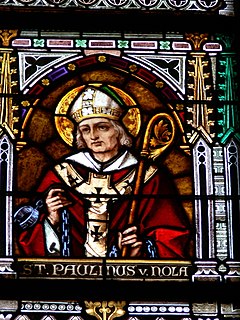
Paulinus of Nola born Pontius Meropius Anicius Paulinus, was a Roman poet, writer, and senator who attained the ranks of suffect consul and governor of Campania but—following the assassination of the emperor Gratian and under the influence of his Spanish wife Therasia of Nola—abandoned his career, was baptized as a Christian, and probably after Therasia's death became bishop of Nola in Campania. While there, he wrote poems in honor of his predecessor St Felix and corresponded with other Christian leaders throughout the empire. He is traditionally credited with the introduction of bells to Christian worship and helped resolve the disputed election of Pope Boniface I.

Vitus, whose name is sometimes rendered Guy or Guido, was a Christian martyr from Lucania. Although his cult is ancient, his surviving hagiography is pure legend. The dates of his actual life are unknown. He has for long been tied to the Sicilian martyrs Modestus and Crescentia, but in the earliest sources it is clear that these were originally different traditions that later became combined. The figures of Modestus and Crescentia are probably fictitious.
Paulinus was a Roman missionary and the first Bishop of York. A member of the Gregorian mission sent in 601 by Pope Gregory I to Christianize the Anglo-Saxons from their native Anglo-Saxon paganism, Paulinus arrived in England by 604 with the second missionary group. Little is known of Paulinus's activities in the following two decades.

Blaise of Sebaste was a physician and bishop of Sebastea in historical Armenia who is venerated as a Christian saint and martyr.

Hubertus or Hubert was a Christian saint who became the first bishop of Liège in 708 AD. He is the patron saint of hunters, mathematicians, opticians, and metalworkers. Known as the "Apostle of the Ardennes", he was called upon, until the early 20th century, to cure rabies through the use of the traditional St Hubert's Key.
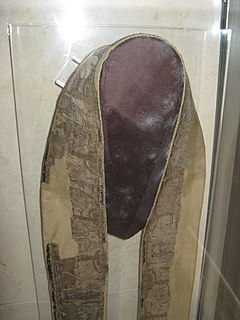
Paul Aurelian was a 6th-century Welshman who became first bishop of the See of Léon and one of the seven founder saints of Brittany. He allegedly died in 575, rumoured to have lived to the age of 140, after having been assisted in his labors by three successive coadjutors. This suggests that several Pauls have been conflated. Gilbert Hunter Doble thought that he might have been Saint Paulinus of Wales.
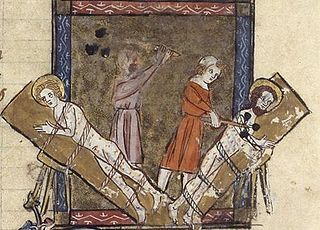
Saints Gervasius and Protasius are venerated as Christian martyrs, probably of the 2nd century. They are the patron saints of Milan and of haymakers and are invoked for the discovery of thieves. Their feast day in the Latin Rite of the Catholic Church is 19 June, the day marking the translation of their relics. In the Eastern Orthodox Church and in the Eastern Rites of the Catholic Church, their feast takes place on 14 October (O.S.)/24 October (N.S.), the traditional day of their death. In Christian iconography their emblems are the scourge, the club and the sword.

Saint Paulinus II was a priest, theologian, poet, and one of the most eminent scholars of the Carolingian Renaissance. From 787 to his death, he was the Patriarch of Aquileia. He participated in a number of synods which opposed Spanish Adoptionism and promoted both reforms and the adoption of the Filioque into the Nicene Creed. In addition, Paulinus arranged for the peaceful Christianisation of the Avars and the alpine Slavs in the territory of the Aquileian patriarchate. For this, he is also known as the apostle of the Slovenes.
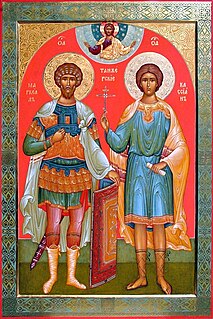
Saint Marcellus of Tangier or Saint Marcellus the Centurion is venerated as a Martyr Saint by the Catholic Church and the Eastern Orthodox Church. His feast day is celebrated on October 30.

Saint Leudwinus, Count of Treves founded an abbey in Mettlach. He was Archbishop of Treves and Laon. As patron saint of the Mettlach parish, his relics are carried through the town by procession at the annual Pentecost celebration. His feast day is September 23. He was the son of Saint Warinus, the paternal grandson of Saint Sigrada, and nephew of Saint Leodegarius.
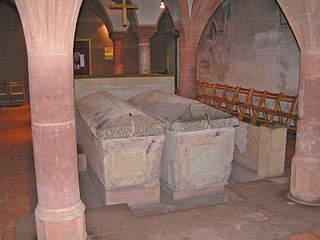
Saint Eucharius is venerated as the first bishop of Trier. He lived in the second half of the 3rd century.

In Christianity, the translation of relics is the removal of holy objects from one locality to another ; usually only the movement of the remains of the saint's body would be treated so formally, with secondary relics such as items of clothing treated with less ceremony. Translations could be accompanied by many acts, including all-night vigils and processions, often involving entire communities.
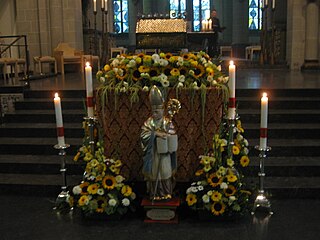
Saint Altfrid was a leading figure in Germany in the ninth century. A Benedictine monk, he became Bishop of Hildesheim, and founded Essen Abbey. He was also a close royal adviser to the East Frankish King Louis the German.
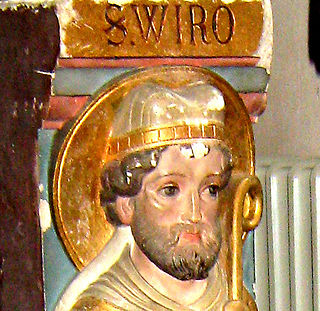
Wiro of Roermond, also Wiro or Wera of Utrecht is a Christian saint of the 8th century. His feast day is May 8.
Fibicius was Bishop of Trier from around 502 to 525 or so.

Gunderich of Trier, also Gundwich was a bishop of Trier, born in the 6th century.
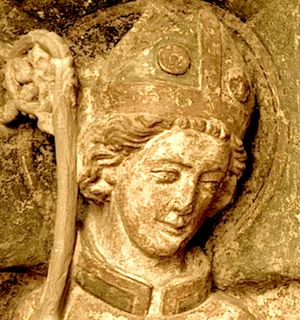
Aureus of Mainz is a Roman Catholic saint and the first named bishop of Mainz. His feast is on 16 June.
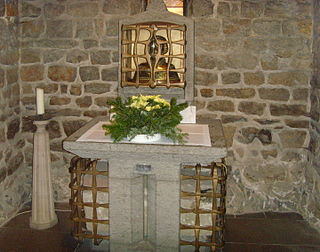
Lubentius is a Christian saint, venerated by the Catholic Church. A patron saint of the boatmen on the River Lahn, his feast day is 13 October.

Hornbach Abbey is a former monastery founded around 741 in the historic town of Gamundias by Saint Pirmin, which soon became a Benedictine abbey. The most important neighbouring abbeys were Bausendorf, Saint-Avold, Glandern, Villers-Bettnach, Fraulautern, Mettlach, Tholey, and the stift of St. Arnual. The neighboring spiritual centers were Trier and Metz. At present, all that remains of Hornbach Abbey are the structural remains of the convent buildings, which have been supplemented by a monastery museum, and a modern chapel with the historical tomb of the monastery's founder.


















